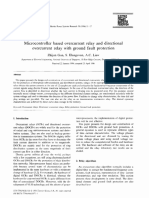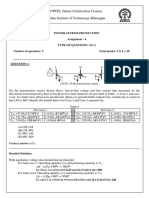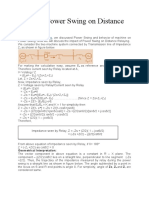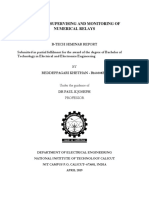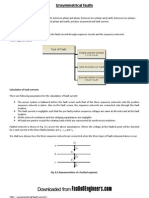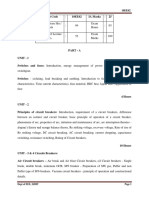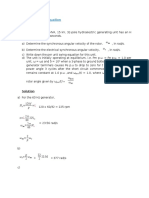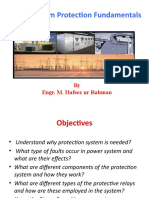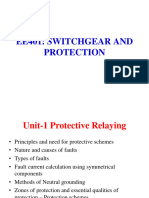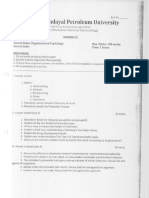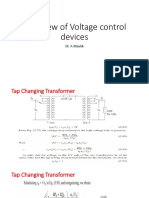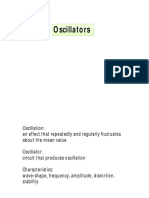100%(1)100% found this document useful (1 vote)
2K views76 pagesPower System Protection and Switchgear
Tata McGraw-Hill Education.bhuvnesh oza,nirmal kumar nair,rajesh mehta,vijay makwana
Uploaded by
anjanaCopyright
© © All Rights Reserved
We take content rights seriously. If you suspect this is your content, claim it here.
Available Formats
Download as PDF or read online on Scribd
100%(1)100% found this document useful (1 vote)
2K views76 pagesPower System Protection and Switchgear
Tata McGraw-Hill Education.bhuvnesh oza,nirmal kumar nair,rajesh mehta,vijay makwana
Uploaded by
anjanaCopyright
© © All Rights Reserved
We take content rights seriously. If you suspect this is your content, claim it here.
Available Formats
Download as PDF or read online on Scribd
You are on page 1/ 76
| Multiple Choice Questions
Muluple Choice Questions enable the
students to have a clear comprehension
of the subject matter. Answers co all
the Muluple Choice Questions are
provided at the end of the book |
OT
International Codes
A lise of Internationally used
codes for relays and protective
circult drawings are given in the
form of an annexure at the end
ff the book The codes will be
helpful in reading che drawings
for protective relaying circuits
Review Questions
Each chapter contains a set of
Review Questions with answers
for the numerical problems
These review questions provide
the essence of the concepts
discussed in each chapter
References
~ [At the end of the book, 2
comprehensive list of book
and journal references are
provided
Introduction and Philosophy of a
Protective Relaying System
to the neighbouring components
The modern electrical power
systems cater to demancs that are and to the overall power-system
network. [cis of vial importance £0
Thread over large areas containing Kt
frajor components like generator Timit the damage toa minimum By
transformers, transmission and quickly isolating the faulty section.
Gstrbution lines, nduction motors. Mehout disturbing the operation of
Snd the bike. fe is evident that in the rest of the sy3tem
Spite of all necessary precautions “The purpose of this chapeer is
Taken in the design and instalation (@) we. dacuss the fundamental
Shauch systems, they do encounter SGncepts underlying power-
Scie condor ors. Some conc nde,
Shon te shore ere 37
or eave sxe damaging oF
ts puley componene bat :
a ony ee fey compen Introduction
() to present an overview of the
Scope for this textbook
TYPES OF FAULTS a
undesired path and abnormal stoppage of
sare termed as fats, Tess fats
“The flow of current t0 the
is and
a) Symmetrical (balanced) fault
‘rica (urbalanced) faults
Faults which involve
cial Faults
() Ay pases. Tripletne (LLL) and ripletne
Symmetrical faults are those
to ground (L-L-L-) falls are syne!
all the tree
ciple ie)
Fig. Li Fouts ima per ster”
som Protection and Switshgeer
nly one or two phases are catego
‘un rd double line 10 2
J as asymmetrical or nbalanced a Single
vi gond (L-L-g) faults are asymmetrical faul
‘The fas inva bee ee round (L: uke
Wn ed ep dt in OL rd oo power se here cane ier faults namely,
-avous pes of faults For 6 oP Ap The R-Y-B and R-Y-B-e are practically the same
BRM courents may be en ines (oreven higher of the rated
ine pment is designed. However, the vector sum is zer,
= to faule-current values, R-Y-B or R-Y-B-g
1, and therefore. with regard
‘Mentica, They, however, differ in case of overvoltages.
VA
“ase of switching ON of # eicuit breaker when the
idgedtozether ether in the machines or in
artcularly when conductors of different
a Fe ounsformers because of failure ofinsuTauon between Phases
ne Shin Tne Wasson lines, (wo phase wires may get shored
ses are inthe same slot of a at
PSS a a or ee nbs. Moreover. n monsoon, he wo phase conductors may swing due
sitzeduces in monsoon. When the distance between these
E+ together by bids, ite string
| oS and toms. Also, the dielectric strength of
(tomas and to to sangng, a poweraremay occur betveen them causing a ine-o-ineTale)a
can is the commonest fault and ean oceur because of fashover across. the line insiTators or
oo) cane offal of ine insulators, de to ighining or stching avervoltage or due to defective insulators,
I~ inet sround fault can occur in machines and transformers too, Abnormal stoppage of current can occur
© as a result of voltage breakdown at equipment due to the occurrence of faults of the
Powers
7 current for
er aximum cure
erp cuent pases oe gr
ec Sot faulturent analysis 8
Causes and Consequences of Faults’
‘ae to open conductors or as.
first kind in some part of the system,
‘The damage caused by faults
cl equipment. Faull current ranging from approximately two times to about
eleewical au
[ead cuent (Continuous Maximum Rating CMR) of te equipment to be protect
and hence Ge ingulation around i. The equilib ie thus reached exceeds the temperature-
‘withstand vale ofthe insulation used. The insulation will thermally breakdown resulting into another fault if
fenedal sep ae ot es. Tiss mown as hermal eakdown ofthe insulation and such breakdown
will occur ater a certain time duration, the value of which depends upon the magnitude of the current. For
voiding such a breakdown, the equipment is required to be isolated from a healthy system by using time-
delayed relays (refer Chapter 2),
‘When the fault current exceeds 8-10 times the full-load rating of the equipment, the repelling forces
seveated due to this large CUTENT Would deshape and desiruct-the-whole-
insantneous pp oa
Hanebisippng feature isrequced tobe used to avoid such an ‘electrodynamic’ damages as-such
mt just within 6 108 cyck
Would be worthwhile to have an :
Se rai ave nde of probably of incidence of faults on the different elements of
Pacer gti Reb of scare of faut in diferent clemens of stm
oven lesa an i frm he simu perentage. Therefore, fre sass of faults on
ered Ral iteresting to observe. Table 1.2 shows the frequency of different types of faults
Introduction and Philosophy ofa Protective Relaying System
Foul Stovstis
Percentage of fais
45-58% —>
‘Table 1.1
‘Underground cables 8-12%8-——> 4
a mies | |
es wee
re 3S |
Miscellaneous
Seis ff on hed he
|
Lr Type of fault
Line to ground fats 80-90%
| Double-line faults 6-10%
ouble-line-to-ground faults 3%
2m or less |
“Tripl-lin faults
“Again faults can be transient (temporary) in nature or sustained. The power arc between two phases of
ftashover across Tine Insulator due To overvoltage isa tansiear Talk. [i may take a few cycles or few seconds.
Obviously, the relay would sense this fault and itis cleared, But, ifthe faulty ine is catering o a large ammount
of power, the generators may go out of step. Hence when a breaker trips in a substation, the operating staff is
permanently instructed to make the breaker ON, asthe fault will have subsided by then. Also, ifthe damage
he to such a transient faut is likely to occur after 4 seconds, the breaker should trip after about 3 seconds,
Since the transient fault may have subsided after about a second. Such a practice avoids instability of a power-
fystem and therefore cascaded tripping in the worst case. Thus unnecessary early tripping of a transmission
line or any other electrical equipment may sometimes more likely cause power-system instability. Thi
1 in comparison to not tripping a breaker when a fault has occurred. Thus, the role of
sometimes more harmful
‘protection engineer becomes more involved and crucial
I is very obvious that a very high-fault current ean cause destrus
power system, and the voltage would drop drastically. Network companies can[Tose revenue) due @ Tong
is ‘On the other hand, industries
interruption in service, as the repairs ofthe damaged equipment coul
roduction-and the inconvenience caused. Last, but not the least,
tion or damage to the equipment of 27
will also be in trouble because of loss of p
‘ynchronism between machines working in the system could be lost and the |\
is the loss of synchronism. The s
power Syslenr-can most likely become unstable if the fault persists. This can lead to widespread blackout
power. Hence one has to find a remedy for clearing the faults, ic, isolating th
healthy system, The consequences of an open circuit are un
‘he healthy system,
1.1.2 Faule-Current Calculations
‘The fault calculations are necessary to compute the value of fault MVA or short-circuit MVA and the voltages
‘This further helps in determining the protective relay setings
reover, the selection of ratings
at various points in the power-system network.
0 a8 to fulfil the requirements of a protective system as explained Iste. Mor
for circuit breakers and other switchgear components like current transformers, bus-bars isolators, etc. are
alysis will be different for symmetrical and asymmetrical faults
based on these fault calculations. The fault an
section from the rest of
balance in the system or single phasin
nm syst ingle phas 8 denedy
ncuneciy fpr nt ead sa pei othe sy UAHA i notton
een paced
ta ofsymmevi lt cculionscnbe oid rom Leis
eee ee (Ci Bang Fundamentals) A mmetial she
tel eset mi Ben tO ato ida fe al curent Tet ae lee pero
fet ism ont Sd acring os ral hi. Ty seb aasot
CE ee if) matanen Tie nibacaied racine i trl) ted a he
Co a a qawortnduson mati ke Thee’ thee ised As he
aon ea ta te conga rte acer leeacer cry.
Cr ed recou ude The fe in sora sy forme
rinse mw)
a enony of kt esi claim for wyatt ar sigue. The
a ae tann be aed dey. The slum hast fe ete by tig
Hee ee lental canna, The cnc of symeal components Was uedured by CE
PCE pid bnmaks ns digo eee old cero emperor oe ptan
reese see nave to atte nual copng been te Hence te aay fret
sri
"he pie teat sosoieceimolazesorecancs ofl components power ssa
seu Ud bart genie er tsces dans often me eed
ov. The inoromeor oft squen vances seqen on te pe assay. Lop LL ad
Tig Alert mrsncto te soprace cc agra which em be ceed lg
tact att Sopene eon als oes sopeangant cla pase newer ais Pl
te memos conpncr cae citad rh a tte pascearen es for wooed
tna Te eae wage acpi geraly gon in any wok fonts seas
1.1.3 Symmetrical Components
We first assume an arbitrary set of 3-phase phasors given as. and . These three phasors are supposed to
be made up of three sets of sequence (symmetrical) components
()Powevesequence Components consists of thee phasors with equal magnitudes and having 120" phase
filament among ther an with posite seguence as sown nF 12) Apitve sequence mea that
| fllows fy and fy follows fy, ian anticlockwise direction, The anticlockwise direction is
Positive for polar representation on cones
2) Negatie-sequence Component
‘ ene " conve ene costs of thee phasors with equal magnitudes and having 120°
nt armong them and with negative sequence as shown in Fi ative sequence
nears opposite of postive sequence as explained above nn nn" FB 120). Nearive se
(2) Zerostequence Components 1 cy
consists of three phasors with equal may
displacement as shown in Fig. 1.20), eine ioe sitesi sve tae
The comeltion ofthe tice arbitrary phaso
a stir fh he symetialcomponet is given ss
Flot In tly
aa
Introduction and Philosophy ofa Protective Relaying System 8
hy toe tre tao
,
Moh NU SLL
|
Ins
hy
(a) Povtve-sequens components (b) Negative sequence components _(c) Zeo-sequense components
(e1 Phase
(@ Phot Iy
.2.Correlavon of phasors wih the sequence components
where,
Thos Io: tao ate a zeto-sequence set
py tye ty ate a positve-sequence set
py: bys fyg are a negative-sequence set
Equation (1.1) can be confirmed vectorially in Figures 1.2(d), 1.1(e) and 1.110),
‘We can consider that the phasors Jy. fy fy are components of a current vector I. The sets of sequence
‘components are represented by Ip, Iy and I} for zero-sequence, positive-sequence and negative-sequence
‘current vectors. Using matrix notation, we can write,
Hg} [mo] [der] [tee]
ty] =| fro] + a} +] fa aa
Ya} (onl Ved ee
{In vector notation, Eq, (1.2) can be written as
T=1y+1,+1,
Now we will establish an interrelation among the sequence components. A complex number a = e!
1.2120" = 0.5 + j 0.866 is used for interelation
“The component Ig, ad Fy are selected as the reference variables and te rest of the components ae
expressed in terms of these reference variables, The operator ‘a’ can give relations tabulated in Table 1.3.
"Bests -
IM ;
The smetcal component cuenta Wy th ys The symnetiea
teanstormation matrix ix defined as A where, _ . enc component
on, Teal, an
To develop the reverse relation with I, on LHS, we need t ?)
SIAPTAEA A pmeanica te tama IM MINERE STA ASIA 0a
i}
i! ve
be calculated by using the properties
3 relations between phase: voltage
rien, Aerhees tween phase voltages and
‘er thes cleans the turer step depend onthe peo
So in matrix not
Once We obtain Ip,
of the positive, nesaive
Fe pote and zero sequence sets. In 4 smi,
quence vollge compainents can be ist
‘the unsymmetrical ful,
[1.20 asNorMauimies
Daring certain situations, a
aré inbals power system behaves
Seld falar, ovtoatng, sername f thee
overvola
mormalities
Prime-mover
Inwoduction and Philosophy ofa Protective Relaying System
ay behave abnormally duc (o over-heating or overfluxing. An induction motor ean run
exe abnormalite all
fing, ete, These anomalies are
‘abnormal operation of the power
Au et
simiormally due uadervoltage, overloading, unbalanced loading. xt
Aili the chaplers oF apparatus protection in this Book, The sustaines
syste is equally harmful as faults,
1.3. FUNCTIONS OF PROTECTIVE RELAY SCHEMES
Protective relay schemes have to sense fault and perform the following four broad functions:
|. To operate the correct citcuit breakers so as to disconnect only the faulty equipment from the system
a quickly as possible. thus minimising the rouble and damage caused by faults when they do occur
the faulty section from the healthy system in case of
2. To operate the correct circuit breakers to isola
abnormalities like overloads, anbalance, undervoltage, ete
4, To identify distinetly as to where
| 1.4 MAJOR COMPONENTS OF AN ELECTRICAL POWER SYSTEM
Jine diagram of a typical power system. Electrical
AY, since this gives the most economical balance
Figure 1 3 shows the major compor
povseris usually generated at voltages between IT KV and
between the cast of eopper, the cost of insulation and the cost of mechanical strength (o resist centrifugal
). 400 kV or higher depending on Tine length
ts inversely proportional
force, This power is then transmitted ata voltage of 132, 2
and amount of power. For a given amount of power to be delivered, the curres
9k as
Receing substation
toon nav
cn son
S| ‘men dae
iv sow rox tax RY,
seta
avin
ava]
temo \
transformer ||| HAY ts 6OKY bus,
4 ott ¥ reaisey La ‘ Dasteibatton substation
Tat anes 4 ra
she vl a lay alae
tee LOS
vottav
Fig. 1.3. Singlesine diogram of © power sytem
8 Power System Protection and Switchgear
et voltages lead to reduction of conductor size and/or of power
to the voltage of twansmission Thus, hi
loss. Bulk power can be transmitted at higher voltages ever a long distance. This power 1s received by a
receiving substation where iis stepped down to a voltage of 66 KV of 132 kV depending on distance of
funber transmission, The 66.V tatsmisson line terminates at a dstnbution substation, whee the voltage ig
stepped dows wo 11 KV. Emansting 11 KV feeders, then, fed power to 11 KV consumers and pole-mounted
transformers in diffrent areas of ees and villages. Pole-mountd transformers sep dawn the voltage to415
‘ols for se by the consumers
The component, showa in Fig. 1.3, are requied 1 be protected in case of faults and abnormalities
Succeeding chapers of ths book deal with apparatus protection. In Chapter S different protective schemes
for generators are discussed. Chapter 6 explains uansformer protection Different methods of protection of
transmission lies are described in chapters 7.8 and 9. Chapter 10 deals with bus-2one protection. Protetion
‘of induction motors is explained in Chapter I
Different component of the system are isolated by circuit breakers. In case ofa fault or abnormality, one
or more of electrical quantities (such as current, voltage, phase angle, power, frequency, etc.) will be se Ise
yes whe ep of waders (CTs and PT) Te cys al pce poy tc charters
and on their operation, a signal will be transmitted o circuit breakers. The fault or abnormality is sad to be
‘eared when the faulty section is isolated by circuit breakers
‘na power system. there is an economic limit to the amount that can be
iam at can be spent on a protective system. The
Protetve sper to be employed depends upon many factors such as probability of occurrence of faults,
Fe a ot la of eauipment. importance of equipment, cost ofthe system or plat location of plant
Seine pee: oadly speaking the protective gear should not cost moe than So the ttl eos ofthe plant
te ye Feet sows the breakup of cos of protstion For typical equipment. As
8 breaker is needed to manually make or break the transmission line oF
tial ced deren PSK te tansison ine of elstlequipment is cst ot
Table 14 Fercenoce cost of 2 reap stem
_ erect _ ee 100% |
Rel panel tne 7
wt tare
Relay room bien
(Current transformers a
Potential transformers tee
‘Total cost of protective gear same
52m
[15 Basic rapping CIRCUIT WITH SYSTEM TANsUCERS
Basic connections of
=
Inwoduetion and Philosophy of a Protective Relaying System
Bust 4
ag
cha
| Rely coer LY as
cep
>, os
vs —_ ,
Ne Footer | Proeine eip
Cato
ely
Fig. 14a) An oc cveut
‘The aviary relay is provided fortwo main reasons. Fintly,if the protective relay contact is required
to ary a high tip col current willbe required to be sturdy enough and hence the weight of the moving
system of the protective relay will increase. This will reduce its sensitivity. Hence, a protective relay is
reserved for only sensing the fault and the auxiliary relay contact does the function of carrying the Righ i
coil current, Secondly, many other functions such as annunciations, alarms, interlocks, ete. are required to
be pecformed when the relay operates This equies many contacts o be simultaneously operate. A multi
contact auxiliary relay does these functions :
vian J t
Fig. 14(B) A de control excut «
‘On operation of the auxiisy relay the trip col of a circuit breaker is energised andthe breaker tps. Thus,
the faulty section is isolated from the rest of the healthy system. The protective relay resets because there
is no low of current through the current coil of the relay. A °S2-a° switch isan auxiliary switch provided in
the circuit breaker Its a mechanical switch, which is ON when the circuit breaker is ON and OFF when the
iecuit breaker is OFF.
The trip coil ofa circuit breaker is required (0 be energised only for a short while. A circuit breaker
ripping takes a time canging from 1 to 5 eycles. A trip coil is not designed for energising it continuously
‘nce the breaker trips. I is pssibe that auxiliary relay contact may get locked (closed) due to some intemal
Mechanism failure. This would mean a continuous current through the trip coil freer Fi. 1.4(b) if no *S2-a°
sith of the cireut breaker provided inthe tp circunt The trp circuit ty isolated by a 32-2 switch once
the breaker ps. This 4s the reason why “NO (Normally Open!” contact of a S2-a stich is provided in the
Up cucu as shown in Fig. AND)
The elements of Fig, 14 (1. citoutt breaker, CT and PT and protective relay are sud to be: components
of ywitchycar These component, i. felays, eeuit breakers andl transducers (CT and PT) ate discussed
at Tength an this book. Chap
(er 2 gives the constructional features of diflerent types of pro relays
(ype. Chapter 3 1s dedicated to their static equivalents. In Chapter 4, numerical
protection using git signal processors or microprocessors is ntreduced. Chapter 13 deals with the details.
of the current tanstormers and pote
ial ansformers used in protective systems. The principles of circuit
‘breaking. constructional aspects and short-citeuit test
ol circuit breakers a
and 16 respestively. Lightning protection is explained in Chapter 17
f r P p
sabed in Chapters 14, 15
| 1.6 TESTING AND MAINTENANCE OF RELAYS
The rellbvbity of a relaying system demands that the
> are periodically tested for their in
arantee for proper functioning of relays. Chapter 12 deals with tes
commissioning and maintenance of relay
seheduled matntenance will ensure
| 1.7 ZONES oF Protection
Since a power sistem consists of equipments of varied nature (e
lines, busbar. ee, ity divided to a numb
There will be eacuit breakers
nerators,transfon
rs. transmission
er of protective zones. each covering ane type of equipment
and relays associated with each zone The somes of protection are overlapped
spot which is unprotected. "The portion, which remains unprotected so that a fault
i this portion Would not be cleared at all. known asa Blind spot
‘overlapping oT TOMS ~
0 that there 1s no bin
Fig. 1S Zones of pro
Introduction and Phiasophy of a Protective Relaying System 41
These zones are decided by locations of current transformers. Figure 1.6 shows hiow current transformers
can be located for overlapping zones as shown in Fig. 1.5. Obviously, forthe fault in an overlapped portion,
the relays in both the concerned zones will tip isolating a larger portion ofthe power system unnecessarily
But this has to be accepted to avoid the blind spot, i. the unprotected portion
poy \
or t cr a
rely ws sone
: u » 7 4
L protection ®
,
= (R)Line relay
Line potest
Lane potestion
Fig
{6 CT locations fr ovedapping zones
1.8 REQUIREMENTS OF A PROTECTIVE SYSTEM
‘The following important requirements are fo be satisfied by a protective system
(1) Reliblity Retiabilny depicts the quality of the protective system, Less the probability of failure, better
"the ela Failure can oem ray, eet beak, onl suits and da eons conversion
1) tem rand Regul an through manne of poste ume, brow of perenne
‘operating the systema and inherent design features and fabrication make the protective system reliable
MSeecnty Seoctviy means slton oa felt ction cca fem eso he ety sem
Sst oie fh ttn operas fr mel as ay tment of te pve em
Sect nat to be ete i coimated sting of pteve ray fleet 2m at si
oscdon cena ules which le dieussed inthe leant chapter ofthe book Differs peer tin
sty te T ocluhwe
10 Power Systam Protection
switch of the circuit breaker is provided inthe tip cicuit, The trp circuit isola
the breake
ip circuit as showen in Fig. U0)
ips This is the 1s provided in the
son why "NO (Normally Open” contact of 4 52-4 sit
The elements of Fig. 14 (se, cireuit breaker, CT and PT and protective
of switehgear These component, 16.1
at lengtt in this book. Chapter
lay) ate Said 0 be components
circuit breakers and transducers (CT and PT) ate discussed
ves the constructional features of different types of protective relays
of the electromechamical type. Chupter 3 dedicated to their Static equivalents. In Chapter 4, numerical
so microprocessors is introduced. Chapter 13 deals wit
of the curtent iansformers and potential transformers used in prote
protection using digital s
nal proves
the details
ive systems. The principles of circuit
breaking
constructional aspects and short-citeuit testing of eitcult breakers are described in Chapters 14, 15
and 16 respectively, Lightning prove
mn explained in Chapter 17.
| 1.6 TESTING AND MAINTENANCE OF RELAYS
The reliability of a relaying system
ands thatthe relays are periodically tested for their integrity. The
varantee for proper functioning of relays, Chapter 12 deals with testing,
commissioning and maintenance of relays
Scheduled maintenance will ensure
| 1.7. Zones oF PRoTEcTION
Since a power vystem consists of equipments of varied nature (e
lines, busbars, ete). 1s divided into a number of protective zones
There will be circuit breakers and relays associated with each zone
so that there 1 no “Blind spot, which
‘occurring in this portion Would not by
‘overlapping aT 7a
eer, trasfomers aesision
ach covering one ype of equipment
The zone of proteton ar overapped
Unpretete The prin which vemasunpe ha foul
ered at al. is known a1 spa gue V3 eves an eso
va Bests protect
= Lane orton
Zones of protecten
Introduction and Phiiosophy of Protective Relaying System WV
These zones are decided by locations of current transformers. Figure 1.6 shows how current transformers
can be located for overlapping zones as shown in Fig. 1.5. Obviously, fr the fault in an overlapped portion,
the relays in both the concerned zones will tip isolating a larger portion of the power system unnecessarily
‘But this has to be accepted io avond the blind spot, i. the unprotected portion
. 1 Gevcer anstormer
# Protection rons F 5
if ¥ N
or or
rely | Buszone ey
protection
Bs zone
rely
~ Line rtetion
| me proetons |
' tne
Fig. 1.6 CT locovans for overtopping zones
1.8 REQUIREMENTS OF A PROTECTIVE SYSTEM
‘The following important requirements are to be satisfied by a protective sytem
fo, ()Reliabitey Reliability depicts the quality ofthe protective system. Less the probability of failure, bet
"the reliability Failure can occur in relays, citeuit breakers, contro circus and due to erroneous conversion
«nti s9stem transducers. Regular and thorough maintenance of protective equipment, knowledge of personnel
operating the system and inherent design features and fabrication make the protective system rlible
)Selectiity Selectivity means isolation ofa faulty section exclusively from the rest ofthe healthy system
Selectivity is absolute if the protection operates for internal faults in any clement of the power system
Selectivity i said to be tlative if coordinated setngs of protective relays of diferent zones ae desided
‘based on certain rules which will be discussed in the relevant chapters of the bouk, Differential protection can
~ €
fe 7
492 Power System Protection and Switchgear
be said to be absolutely selective, whereas current-time graded overcurrent protect
berate absolutly sles when a protection and distance protection
0) Speeds cin tha ater te sped of operation of cle of sth sem ys a
breaker es ste damage oe equipment. A> sch the wutpmens are sore re fo figh faut
caren and herent willbe pital damaged the eupment he saan beaker pe
ast. The time-setting o the relays has to be decided on the basi ofthis short-time rating of equipments to
ts Tem «on the bass ofthis shore rating of equipments to
Another important reason how the speed can help an be
ed can help, can be appreciated hy considerations of power system
subi the falar noclearedin une (dependingon te magnitude of shor cucut power) he gencsars
of he oer ye may a0 fe exe acer a cmp dw al the generates
stem may seus in al dat of power. Th wht cal cascade ring. Reference
to Fig 1.7 will make it clear thatthe shorter the time a ful is allowed to persist, the more 4 load can be
tuansfered between given points ofthe power system without loss of synchronism. “
~~ Ti ground aut
‘wb fal
Toei
Ta ieay beaker) me =
Fig. 1.7 Power wonsfer during vanous fats without lss of synchromim
Relays siuldnae made operates than
teat than Sto 1Orilisecons. as oer
‘operate due to transient conditions like lightning and switching surges.
(4) Diseriminetion :
(4 Bucriminaion | pci system sould be seo dscininae hwo land ta eon
ven when the minimum fault current is Tess than the maximum lead cument A fuull and an over,
sets i aro he pattie hen. Thee ma be sane meme sca
toveen sich similar-looking conditions. There are other si rete lay hast be Sh?
Seren sich sila eon situations alsa, where the relay has to be
Sosante sande kta emu al
‘mame san atl call nmoderneonsd encnan ie pe Sw
canis c while protecting the tansmisson lines. Furt
msqcso ernaton pence aan shot hen meyecne cee
‘may unnecessarily
Introduction and Phiosophy of» Protective Relaying System 18
(5) Stability “The term sibility is often used to desernbe the quality of a protective system by virtue of which
it remains inoperative under specified conditions usually associated with high values of fault currents. Strictly
speaking. 1 is a quality that only unit systems ean possess because they are required to remain inoperative
conditions associated with faults outside their own Zones
under
(6) Sensitivity Sensitivity refers tthe minimum level of fault curtent at which operation occurs. In other
words, it is the fault seting and is usually expressed in operating quantity referred to the primary of #
transducer There isa dilference between the sensitivity ofa relay and the sensitivity of a protecuive syster
‘The sensitivity of arelayis expressed as the apparent power in VA required causing its operation: thus 3 1-VA
relay is more sensitive dan a 3-VA relay
| 1-9 RELAY OPERATING CRITERIA
Primarily, it seems thats relay should operate when ether a current or vot
‘ern mit or decreases elow a certain limit Ths, the fey seems tobe operating unde faulty conto
Bu ay such. this isnot the onl criterion for the relay to operate. The relay cnterion i 0 be so chosen that
Should occur only under falt condition against which the relay is designed to protect the power system but
Should never occur under conitionsapuinst whic the system doesnot requite ameroption.
“The relay operating ertria becomes complicated a the relay should operate i faulty conditions and s
should not operate when there sno fault. The relay should operate forthe faults in its operating zone ony and
Should remain stable forextemal falls. The relay should operate only for abnormal situation it sealed for
tvoperat, The other feloys wil ook alter othetabmormalites and the relay i consideration should ignore
the ouker abnormalities barring the only one for which it should bea guard, The relay should not operate ven
hon cert sbnormalty fault or phenomenon look like a fault Let ws understand the following examples
tommake the relay operaung criteria clearer.
A simple way to protect a circuit is compare th
sitferential curent passthrough the slay. Hence a
‘oreurrentc the undesited path fash. Ty inp
se of power exceeds beyond a
.e currents entering and leaving the circuit and make the
‘passage of eurrent through the relay indicates diversion
Ve principle soon becomes complicated because ofthe spill
Chien through the relay in ease of non-ietical current transformers. This spill current has o be segregated
eam the relay current dve to a minute fault, Moreover, in transformer protection, inrush of magnetising
cant which appears on one sie of the transformer only would cause relay aperation if diseriminatony
Hocking features were no added, Such a blocking feature, called harmonic restrain, somtimes tas to Be
anblecked because harmonies may appear during Laut conditions also which demand tmpping,
“Acar sacond example case of generator protection fick faire elay should not operate fr either pole
slrnang conditions of dac to power stings. Simlay. reverse power relay should cperate for tare of
perp over omy and ot for steria faults nthe generator Asa hind instane, no ela am any protecune
‘System should operate woen a potential transformer Fuse fils
‘We wl discres in deal about the complexity ofrelay-operating eiteria in the sueceeding chapters
[1.10 main AND BACK-UP PROTECTION a
the int line of defence. There must bea second line of
hat the primary relay othe transducers
(alo operate fo sme
used
s, which vill clear the foul
to which they give the signal to clear the faut,
Main or primary protective schemes
defence provided by back-up sch
feeding them or the circait breakers
14 Power System Protection and Switchgear
‘There are three kinds of back-up relaying
(0) Reley Back-up In this relaying scheme, the main tclays, thei cumTent transformer cores, potential
transformer cores, et. ate duplicated, This system of back-up protection is very costly and used ony af
‘equipment to be protected is very costly and important
(o) Breaker Backup When a feeder breaker fais trip on a fault, the feeder fault becomes viually a
busbar fault. In breaker bick-up scheme, a time-delay relay is operated by the main relay and itis connec
to ip all the other breakers on the bus if the proper breaker has not tripped within pre-set time
(6) Remote Back-up Remote back-up is provided by a relay on the next station towards the source. This
‘emote relay will rip in a delayed time ifthe breaker in the faulty section has not tripped due to some reason,
‘This is the most widely used form of back-up protection
|. EVOLUTION OF PROTECTIVE RELAY TECHNOLOGY
Electromechanical, Static, Microprocessor Based and Numerical Relays
Electromechanical relays have a long history of application, They are ragged and reliable and are stil used
in power system protection, But as these relays consist of moving part, there are problems of friction, low
torque. high burden and high power consumption for auxiliary mechanism
With the advent of ICs (Inegrated Circuits) and chips, the static protective relays have replaced the
etimansos relays
delayed
Electromagnetic Relays AT
4 Relays can also be classified by their constructional features; ¢g.. attracted armature-type relays,
induction dise-type relays, induction cup-type relays, balanced beam-type relays, ete
5. Relays which use electromagnetic principles in their operations are called electromechanical or
electromagnetic relays, anes that use static (electronic) components in their construction are known
1s static and the relays which use pre-programmed microprocessor and digital circuits are said t0 be
digital or numerical relays
6, Special function relays such as reinforcing relays, tipping relays, alarm relays, et
| 2.2 THERMAL RELAYS (OVERLOAD RELAYS)
Before discussing thermal relays, the difference between overload and overcurrent needs to be clarified
When the electtical equipment draws more current from the line 1o which itis connected, the equipment
is said to be overloaded. Overload does not mean a fault, When the fault occurs, a current is diverted to an
fnesired path because o” failure of insulation or other abnormal conditions. The current drawn from the
line because of such a fault is termed an overcurrent. Ia transformer rated for 100 A, is loaded by 120A. it
je sad to be overloaded. The magnitude of the overcurrent on the other hand, will be comparatively higher
than the overload.
An electrical equipmert can withstand overload for many minutes or sometimes fora few hours depending
‘onthe mapnitude of te overload. Accordingly. the thermal overload relays are requised tooperate after alonger
overcurrent relays, which have to operate within a few seconds or even milliseconds.
time as compare
“The wet thermnal relay" may suggest a device which directly measures temperature, More often in fat
iticmsed to deveribea device which measures the heating effect ofa current the temperature measurement
being, tus, obtained indectly
in carlic times a simple bimetal stp, thermocouple or RTD. or more complex thermosenstiv devices
score eae But all hese cevices take avery ong ime 0 reset Thus, ho restart of an indoction motor of hot
weelung oft tansformer or anyother electncal equipment wos not posible. potently casing heavy
rceeiny lmcs for the end consumer an ow of fevenue eared by electricity hoards, The improvements
to hs feature using static relays wl be discussed in the evant chapler.
van important pont te be undersiood and very relevant to protection engineers is matching the thermal
rele haters with he thermal withstand characteristics ofthe electrical equipment tobe protected. This
point will be elaborated n detail in the following chapters
However, at this juncture. one should be aware thatthe heat developed by cletrical equipment is
propanol to ER, whee Tis the cae, Ki the resistance ofthe winding ofthe equipment ans
reer ch the curent passes Ths in tur, causes further increase in temperature of the winding
Fuels heat teas dspated natural, by Forced ait by water, by some get.) andthe rate a wich
Fe caeapeed i proportional where 1 she temperature differentia (emmperature reached — ambien
repens Thi wl bis he emperatue as pont (vale of caret) where est generated equals the
sae sfipted. ‘The tenpertue is known 3s egiirium temperate, Dang noma loading of eipmen
the aquirium tepesare is well within the temperature withstand vale, This withstand temperaue
tendon the ispeof sulting material used, When curent exceeds 110% ofthe rated cutet ofthe
carter the equi temperature wil exceed the withstand limit of the isuation provided, Cetin
points ar to be understood a this sage
Ti Therime within wbich the temperature of te electrical equipment exceeds the rerperatre withstand
ion is iaversely proportional tothe vale of the overload h
1B Power System Protection and Switchgear
(Ita graph is drawn for ume v/s current with respect to) it isan inverse characteristic where the time
reduces exponentially. The exponential rate is defined by the time constant. A typical curve is shown
inFig. 2
Relay
2 characterise
‘Themal
wstand f
harcensic
10 20 40 40 so
Muluples of rated cuett of quent
Fig.2.1 Choroctensc of thermal lay
(uti) The relay is connected across a CT secondary, The relay setin
lume constant ofthe relay and that of the
50, the temperature of the relay and the te
of the overload.
is to be chosen appropriately and the
electrical equipment should be approximately the same. If
"mperature of the equipment will be same for a given value
The characteristic ofthe thermal relay and thermal withstand character
together in Fig. 2.1. The thermal withstand chara
damaged after a cenain allowable time. Obvious!
source before this time is reached so that i
resulting in saving ofa large downin
Eaxaly importa tht. 2 margin of around 10% (in tems of ime) shouldbe allowed. Too fst ripping
{Sot desirable because 120% or 140% ofthe rated current can be safely withstood by insulation for abet ox
pane en oe tla may be tansint and may vanish within LS minutes or all an hour tis alse quite
ready he ta have fo overload the equipment fra smal time deliberately. ‘The relay in such cses
Pratt fet ePerate for an allowable withstand time. Hence the characteristic matching curves a shown in
The relay characteristic is supplied by
Fig. 2.1, the relay characteristic is draw
ie of the equipment are shown
teristic shows that for a given current, insulation will be
ly. the relay should isolate the electrical equipment from the
he equipment is not damaged further and no fault is developed
y the manufacturer as time of operation v/s multiples of set value. In
in terms of the CT primary current
“Thermal relays are used for overload protetion of electrical equipments
| 23. INSTANTANEOUS OVERCURRENT RELAYS
mae oaten ly one, whic has no ition time-delay In actual practic here canbe
te 0 ne fen 4 ci operates within 20 t0 60 milliseconds, i is said to be an instantaneous
‘S8snel Prtics to define the time of operation of the instantaneous clay at ive times
the set salve
Electromagnetic Relays 19
atiracted-armature
lated, we will discuss
Tee ane vas om f oan nner by
pypesuciondse pe ndcioncup pean ee ay Ash ae toe ot
0 0. Relays ing tine
Drops pikapranof schlieren AF: Rl ve
topicleap) of 975 are avalable in the market ‘This ratio should not be 100%, as it would result
ste ek cure ™
Ta aplaons when cure! puts org ena sta mae
un Ts hcl pags earen pase gh 0 When Bs se
Freeh in armani euch, pig manning xn Ban sae 8
re pee 8 somal sed
copra ete pe ao a
Tens by cane at emf e cereale To aid
set tomas Ts eth soy fee. Sch
vie y. Instantaneous overcurrent
Mintle se ihn isc vee iy tn ec
canyon ed etn verre ey pve ao era
Saar emit eating chaps The mssntne neces a Pi
sero Sect cqipmen incase of hehe! av
jo (drop-oll
hattering
ed armature
‘slight spring bias is
lem does not exist in
| 2.4. TIME-DELAYED OVERCURRENT RELAYS
“The delay i apraio of ey importa equine in
andback up protection re dente amount of ine dey on 0
0p delaying arrangement, which yields
the tme-praded system. The time of operation being inversely proportional to the current magnitude is
anoter ype of delaying rangement ee cient grain
‘The various time delayed re covered by the following general equa on
where
4, = pick-upeurrent
e the relay characteristics,
and 's which determine the relay cma weet
“The various types of time-delayed overcurrent relays used in practice are described a
sections.
| 25. DEFINITE-TIME OVERCURRENT RELAYS
“The detinite-time overcurrent relay operates at the end ofa definite set time, once the current exceeds «pre
set value. This pre-set value ofthe cunrent is termed as pick-up. seus
re were many electromagnetic oeletromechanical arrangements prevalent to dla th
_ relay. With the advent in static (discrete components} methods of
ed. This method will be discussed in Chapter 3
Incarly days,
‘operation of a relay or drop-off of
delay, nowadays, static versions are us
20° Power System Protection and Switchgear
111 0andn+0in Eg. 2 1. thedefinte time characteris will be obained, Generally, an instantane
overcurent units provide as inbuilt aangement nthe sae relay caning. Obviously, the seting rage
of insiantaneous overcurent unit wil be higher. It is a general practice for overcurent ime delayed units to
hhave ranges as follows:
Pick-up setting is in the range of $0200 of relay rated current (rated current b
‘nthe market are
LAr 5A). Time-
sting eng normaly ea
srs
tis
* 6-005.
Te phsetsatancous omits provided with sting ang of 400-2000 ofthe ela rated cure
A ea ay hb mtmnsns opstatenen ) seing eHaann =
The deftestimeovereurent re
. curently ind thee aplication for protection fa rail feeder whe
gtr psie ating rae eel Tee ed ‘velo arm
wc Potton of induction motors. Tes applications wil be dal with in relevant
| 2.6 INVERSE-TIME OVERCURRENT RELAYS
oe disc travel in inverse time relays is limited by back-stop on one ide and conta son anther Ook
ranma Produce torque. hence split phase or lag coil construction is used. “macs on another One
secondary terminals are brought to th Ie
Sp pa ae ens ees
‘current can be varied (as driving torque is pro
caren canbe i torque is proportional to amp-turns) by changing the tappings and hence the
‘When the dise completes its travel (or
nce the current exceet
fixed contacts. thus relay operation isco rr he aaa, MEStiE)- the moving contacts sor the
ons complete. Hie the main aren. th higher sth doving tng a
An lesser time of operation. In this way a relay gives inverse
Protection,
Electromagnetic Relays 24
Define me characte
Normal ners hares
Iyer turers
Figs 22 Chorocterinic f ume delayed overcurrent relays
22 shows three characteristics on the same graph. Normal inverse characteristic follows the
Figure
cquation t =k This causes certain difficulties that wil be discussed in Chapter 7. The definite-time delay
Sharactenstic is also shown, The hybrid of the two (which is very useful) is the normal inverse [DMT
Sharactenstic. Figure 23 shows the intemal construction ofa typical IDMT overeurtent relay
In any overcurrent relay, two facilities are common
(i) CT shorting arrangement to avoid high voltage being induced in CT secondary and relay coil, therchy
the control pane! 10.
(iiy Trip-cieuit isolation arrangement to avoid tipping of equi
being tested periodically
‘The glossary of common terms used in conjunct
follows
(1) PlugsSetting (PS) This is given in terms of ether ampere or percentage of relay-rated curren.
Setting isthe threshold above which the slay will stat operating
(2) Plug-Setting Matiplier(PSM) The multiple of plug-setting current is known as PSM, The characteristics
are plotted usually in terms of operating time vis PSM.
(8) Time Multiplier Setting(TMS) ‘The operating time
values of the current. The operating time is specifi
"TMS at 1.0, If lower time of operation is required, the TMS can be ¢l
dial calibrated from 0 to .0.'The arrangement moves the back-stop of the disc
the relay comes to the normal state from its fully
as resetting time. The resetting lime is specified for
dise to the original
ipment being protected while the relay is
tion with inverse time overcurrent relays is given as
Plug-
for inverse time~current relays is different for different
in terms of seconds at 10 times the plug-setting with
‘hanged. TMS is given in the form of a
(4) Reseruing Time The time within which the disc of
‘operated state, once the current is discontinued, is known
the time dial at 1.0. It should be noted that the term resetting indicates the return of the
position and is different from the term drop-out (refer glossary),
20° Power System Protection and Switchgear
Itk-s0andn sin Eq 21. dstintetie shratrstis will
; 2, ime characterises will be obiained. Generally an onan
‘overcurrent unit is provided as in-built arrangement in the same relay casing. Obviously, the seting rae
of instantaneous oxecuent twill be bier Is. general race fr overcame Gime dlsed ences
have ranges follows
Pick-up sting is inthe range of $0200 of rela rated cument (ate
selting ranges normally available in the market are tedearen bring | Aor 5A}. Ties
+ Ol-Is
+ 110s
+3305
+ 660s, ete
Ano nsamanes i provid with ting ange of 400-200 fhe ely te am
(infinite), bit instantaneous operation is given by setling the instantancous unit at ~~
| 2.6 InvERSE-TIME OVERCURRENT RELAYS
se om rede ne Ree poral cmitn ised nn OH
Sich ha for ay opp. he whole fone lego ie cl eve soa logs hase
on ol eing bridge. Mechanical nstuning torque beng conan pekup
‘current can be varie (as driving torque is propo
camara be i Corque is proportional to amp-turns) hy changing gs and hence:
ib 'y changing the tappings and hence the
When the dise completes its trav
ncn ie ome ne the egal Exceeds plus-setng, the moving contacts shor the
‘omplete. Higher the main current, the higher isthe dr
is the driving torque and,
Current setting rang 'ys as 50-200% of relay rated current, in seven equal
ges are available for phase rel
mt sees relays as 50-200% of relay rated eu
teps. For ground relays, the onstruction is similar 1 phase ays ba me ae 5-204, 10-409 and
reason will be discussed in ot vi
ussed in other chapters dealing with equipment
a
Eloctromagnetic Relays
Define ume charactenstc
‘mal aver charters
INT turers
Fig.2.2 Characters of sme-eloyed overcurrent relays
shows three characteristics on the same graph. Normal inverse characteristic follows the
equation It = k This causes certain difficulties that will be discussed in Chapter 7. The defiitetime delay
Characteristic is also shown, The hybrid of the «wo (which is very useful) is the normal inverse [DMT
‘characteristic. Pigure 2.3 shows the internal construction of atypical IDMT overcurrent relay.
In any overcurrent rey, two facilities are common:
i) CT shorting arrangement to avoid high voltage being induced in CT secondary and relay cil thereby
the control pane!
Gi) Trip-circuit isolation arrangement to avoid tripping of equipment being protected while the relay is
being tested periodically
“The glossary of common terms used in conjunction with inverse time overcurrent relays is given as
follows:
(1) Plug-Setting (PS) This is given in terms of either ampere or percentage of relay-rated current. Plag-
seitng isthe threshold above which the relay will start operating
(2) Plug-Secing Mukipler (PSM) The multiple of plug-seting curent is known as PSM. The characteristics
‘are plotted usually in terms of operating time v/s PSM.
(8) Time Multiplier Setting (TMS) The operating time for inverse time—current relays is different for different
values of the current, The operating time is specified n terms of seconds at 10 times the plug-setting with
"TMS at L.0. Ira lower time of operation is required, the TMS can be changed. TMS is given in the form of 2
ial calibrated from 010 1.0. The arrangement moves the back-stop ofthe disc.
isc of the relay comes to the normal state from its fully
Town as resetting time, The resetting time is specified for
of the disc to the original
Figure
(4) Resetting Time The time within which the dis
‘operated state, once the current is discontinued, is kn
the time dial at 1.0. It should be noted that the term resetting indicates the return
position and is different from the term drop-out (refer glossary)
22 Power System Protection and Switchgear
5. shape core
6 Backstop
7. Moving coast
5 Shaft
9. Spar spring
10. Fxedeontact
FFig-2.3 Elecvomopnenciype inducvon dsc rloy
| ——
|, shares
{Xen mene
\\ le aac
(Noma ene
. chen
Electromagnetic Relays 28
100. ee
“Time of operation of relay seconds) ——>
al LL
%y
Fig. 28) Time-current characteristics of IOMT relay (normal inverse)
(5) Overshoot or Overtravel_ ‘This is defined asthe time to close the contacts at twenty times the plug.setting
‘with maxinfum disc travel (TMS =I.0) subtracted from the time to reach the point when the current must be
shutoff in orde to prevent the contacts from closing due to momentum of the dis
(Characteristic curves and typical internal-ctcuit diagram of normal inverse [DMT overcurrent relays are
shown in Figs 25 and 26 respectively
‘The time of operation of a normal inverse IDMT overcurrent relay can be calculated by the approximate
formula as follows:
‘Time of operation of a relay = TMS
a
ogo PSM
24 Power System Protection and Switchgear
toc rest
‘ ws 105
Hao we |
20
‘uae ot
Fig Inernotconnecion gram of verse ume
togrom of 1 overcurrent rely ype IOC (Courtesy VX L Lands and Gy Li)
Legends for Fig. 26
1OC : Main Relay Coil
JOC/ : Moving contact mounted on dise-shaft
19S: Alay Snea
IVS/, IVSI3 : Contacts of IVS unit SMe Nes Coase ere
Electromagnetic Relays 25
IAT High-set instantaneous unit
ITI, INT : Contacts of
(a) : Maximum tap shorting bar
(): Auxiliary current transformer
(©) Internal resistor, if requited
(6): Setting pot for setting high-set unit
() : Red handle for test switch
() Test switch for trp isolation
(g) CT shorting switch
() : Current test jack
Terminal Designation
(2), ): Auxiliary supply
Tap
(Test
(7). (8) : Input from current transformer
(), (10) Alarm
ther relays available areas follows:
(0) Very inverse IOMT relays The characteristic ofthese relay i steeper than that of normal inverse relays
(refer Fig. 24).
{i Extremely inverse IOMT relys The characteristic of such relays is more stecper than very inverse relays
(refer Fig. 29),
(ii) Non-directionel normal verse self powered IOMT relays These relays are useful in unattended
substations (refer Section 2.8).
(ix) Voltoge controlled evercurrent relays Refer Seti
(0) Long time-delay reloy (thing 30 seconds at S times the plugsetting) It may be used for dual (overcurent
‘cum overload) purpose
{1 13 second normel inverse IDMT relays (Time of operation of the relay is 1.3 seconds at TMS = 1.0 and
PSM = 10)
“The general equation that covers the standard iverse-type characteristics is given as follows
jon 29,
‘ime of operation of a relay = = — x TMS.
Time of operation of 89 = psa] *
“The value of constants erand vary for different characteristics, These values are given as follows:
Slope ofthe tie -current curve se a B
‘Normal inverse 002 ona |
Very inverse 00 Bs
Extremely inverse 20 00
Long Time inverse 100 1200
25 Pome System Protection and Smitchgea
2.7, IDMT OVERCURRENT RELAYS
2.3, the electromagnet gets saturated at high curren values. Accordingly, the
dis speed does not increase as given by the inverse a. This ft gives rise feature known as Definite
Minumom Time feature, and the characteristic obtained 4s known as laverse Definite Minimum Time-lag
ADM characteristic (Fig. 25).
Figure 2.6 shows an intemal connection diagram of atypical IDMT overcurrent relay giving normal
averse characteristic:
Retering to Fig. 2
can be obtained with = 02 and &
For the relay depicted in
and Eq. 2.1, n= I gives the normal inverse characteristic, andthe IDMT characteristic
0.14
| 2.8 NON-DIRECTIONAL NORMAL INVERSE-TIME-OVERCURRENT RELAYS WITHOUT
THE NEED OF AUXILIARY SUPPLY
The basic construction and intemal-connection diagram of a non-directional, sel: powered, normal inverse
‘overcurrent relay i shown in Figures 27 and 28, respectively. An ac series tripping is used where a reliable
dd tripping source is not available. The tripping power in case ofthese relay i taken from CT secondary,
This unit (IAS) is fied with a normally closed heavy duty contact. Under normal condition, a CT
secondary current ts not allowed to pass through the trip col of the circuit breaker which is bypassed by the
NC (Normally Ctosed) contact of LAS, When the unit operates, the CT secondary current flows through the
trip coil and tips the breaker.
FIE-LTSe-powered (OMT rely (Couesy reve TAD ted)
| 2.9. VOLTAGE-cONTROLLED INVERSE-TINE OVERCURRENT RELAYS
rd ice ie gener i Fu oct th sety-te cuenieshan he
rows inpedance is mow than 100
‘overeurrent relay cannot be used as it Ise he oagee imble mesecime
Weedanomer eran red neuen
le
Instead, the voltage-cont
Electromagnetic Relays 27
cr
0c |
____—___— =
[toc oe ]
Tus | 10C: Coot dsc rely
1 Is Coit stannous hight unit
TAS Coils seies nipping it
2570: Trp col of crew breaker
Interetconnectan dogrom of relsype IOCNN
1 to be used an ths case. The relay offers two time-current characteristic curves. One curve offers
is required 0 be used an ths c
wiraccum wage collapses and Rene pI
io adr ama atage cnditon, When a alt ecu. Hage ie
ae tg lite gia abe Te me of operation of he ely wl hs be eae
Second curve, hence, offers short-circuit protection of a generator.
Fin 28
Legends
1
2
3
3
“
5
©. Spealspane
10. Fhdcont
21. Comactofwndevolage hy
TR Restor
Vottoge-contale inverse time overcurent relay
Fig.29
2B) rower System Protection and Smitchgeo
General Description
completed through a resistor which is shorted by the normally closed contact of an instantaneous undervolt
unit incorporated in the same case. sersiage
The lay ha two operaing chasers jd
determin bythe pesto of te istantuneousunderolage unit monitonng the generator vole, Ud
Is usualy energised andthe short sross the resistor in he shading cal ecu i teoaned refer Fig. 2.9)-The
3 tncs Ut te meal sting coves ae 8 ane of loes nerd ete na
flay operates in accordance with the fault characteristic. Bo
Fig 210. h Both the characteristics ofthe relay are shown in
Fru characersic
2466 1
116 8 20
rm
FIE:2.10) Chorctersic of rtageconledevercurent ley
[2:10 iouction-cup revavs
‘The principe of producti
™ Production oftorgue by induction ree
relays. Un ths case a cylindrical ep
Electromagnetic Relays 28
Legeoss
Tack stop
2 Moving contact
3 Paadcoaaet,
4.Core aed |
Si Movig cup
Fig. 2.11) Fourpole nductioncup relay
construction, as shown in Fig 2.11 is used for realising directional feature i
directional relays is given in Section 2.13 ofthis ehapter.
fe in-built elements in directional overcurrent relays (to be discussed in
"These units find application as @ phase comparator relay
in arelay, A detailed treatment for
Induetion-cup units are wed asthe
Section 214) to give directional control tothe relay.
tobe discussed in Section 2.12
[2.11 DIFFERENTIAL RELAYS SL
.1 Cireulating Current Differential Protection
Frgure 2.12 iustates the pnp of circulating cuen ferental protection. The principle cn be bes
canine by Kchot'sctrent Taw. As sbown in Fig 212, the current entering and leaving he equipment
eet are compared I these coments re nt equal, it means that hid branch hasbeen created and
the current equal to the difference of the two currents being ‘compared flows through this third branch, which
aera ate cument proportional oth fal-arent sade pas through te relay, which senses
the fault current leading to its operation.
Fig. 212), Poncple of sme diferent relay
80) Power System Protection and Switchgear
Refering tig. 2.12 ther is no interna ful normal od conn and
l,i. nnora ll condion an extemal heh a
(sch a) condin, the cures enering and evince pected wing wl be same in agit
and phase tlton, Therefore instantaneous ales of CT secondary cen, an willbe same a all
isan. Ths, vious mean tht the urea dough the ea 1) iB ero a he ely Wil a
cpt, Howe fran ema kh at Fh eso en a dsb
If Head eee pert (wil ow tava el Issue
ier than the eay pick-up, ne relay wl operat slag te protected equipment rom the sem,
‘The protected equipment andthe cue ranslormers are insted on the turbine orf itis a generator
and inthe switchyard incase ofa tansfomer or busbar, The reli inslled in he contol room; hence
the sono ning eg toe done, These wits te own pl wie and the cue j, and
‘nown as circulating pilot currents. The relay is of instantaneous ie zone tends from
CT, to CT; as shown in Fig. 2.12 - ‘ype The ns of ptecton extends om
The polity of CT very impotan in diferent
nt in diferent poten, case otherwise um of to
and ts 1¢. fy + 4 Will flow through the relay. Naturally the relay wil giving rise
to uncalled tripping of the circu breaker - neil prance ii condoning ro
The circling curent dierentalprzcton
al prtection applied fr diferent rotston of pene, r
cart at protection of wanslomer,bstr diferent pct and petetn of meters, deta of
application are discussed in relevant chapters, _=
2.11.2 Opposed Voltage Differential Protection
Figure 213 ilsnatesthe prc ofan ppv oh
cof an posed lage dren protection scheme The
secon Ts pono nid ey igo CT, spp
i ecient he pening eel hy bat heen
cn both theses le sacnduy cares cure atome oe ae ae aloes
enh es ransom on wo ses oper each a
shee eh Hes rar nn pla Di el ae
its scab pepo ae ee
ends, flows through the relay coils and if this is higher dl
ere ey igher than the relay pick-up, the relays operate to isolate the
en
* taninows oercumen relays 4,
won ,
FIE-213 Opposed vohage afererta pr
Electromagnetic Relays 91
Since no current flows through the secondaries of current transformers under normal operating suns MOR
the whole ofthe primary amp-tums are used Tor exciting th wansformers. This ceates lage Mux causing
vv ton of CTs and inducing high vervoltage which ean damage the insulation of CT secondaris, For
srteason, the current transformers used in such protective scheme are coreles of of air-core ‘ype, As
Pe Niteluctance and as reactance of air path high, the flux feduces 10 » small wale even eth WEB
feimary amp-tums, none of which are balanced by secondary amp-turns 3 normal condition
Because te curent is zero under normal conditions, this scheme forms a bass forts application in pilot
wie unit protection of feeder.
2.11.3 Biased or Percentage
iferential Protection
“The protective scheme discusedin Section 2 11.1 gives perfect discrimination if both the CTs hse exactly
oe eeal saturation charaensc. However, i practice it found Gat the characteris of two CTS
aancmnvide exactly even If they are produced by the same manufacturer. This may lead t0 flowing of
weit carent even tough the primary currents are equal (0 itera faults spill curent exceeds the
‘ering ofthe relay, an undesirable operation may occur. This spill cue is especialy lars fo a hess
se through) fal, One ofthe methods to avoid the uncalled operation ofthe ela isto provide aased
differential scheme of protection.
“The biased differential relay has two coils. O
restrains the operation of the relay. The other coil
ne coil is known as the restraining coil or bias coil, which
the operating coil, produces the operating torque for the
fea) as already explained in Section 2.11.1. When the operating torque exceeds the rewaining (ers the
Tray operates, The operating coli connected atthe midpoint of the retaining coi 35 shown i Fi 2.14,
Free eaiing col has turns the cutent lows through N/2- tums and flows through the other Half of
dren N/2. As the torque is proportional to the amp-turns andthe average amp-turms being equal 10
iy iN
2°23"
the average restraining current will be
“The relay has two types of settings. The first se
‘The basic setting is the value ofthe operating col
ed in terms of percentage of rated current of
is defined as the ratio af minimum current through of
ual 10 (i, +1392
“ring iv known as the basic setting or sensitivity setting
ceurent above which the relay can operate. Ths is offen
felay. The other setng is termed as the bias setting. Bias
petating col for causing operation Tie average
Fig. 2.14) sed offerenvalecloy
'32))_ Power System Protection and Switchgear
G9)
ie Se bias = ML
Grae
00
fora particular case is more than the pre-set bias and the current (i, ~,) is
the pick-up ao
mor tan ie Base Sting the rly wil operate. The term pick-up rao should not be mixed up with We
ete ten pick-up ofa relay. The term pick-up ratio only means thatthe relay becomes operative if the
pick-up ratio shiher than the bas sting. In case of extemal faults, there canbe a high spill current, ~ i)
But + 4)/2 wil kobe high, ducing the pick-up ratio Below the bas sting, hus making the relay stable
agninst external falls.
The operating characteristic of such relay is given in Fig. 2.15. The effect of increased bias sting i
to increase the slope ofthe characteristic. When the pick-up ratio is moe than the bas sting, the pick-up
rai point wl ie inte postive torque region of ig. 215 and if this ratio is less than the bias sting, the
relay willbe inthe blocking region, Figure 215 also shows hat fora high ough aut the curenty-1)n0
tore remains equal to zero because of CT errors and ambiguity of CT saturation characteristics at this high
curet ut tke a shape as shown inthe figure. The figure makes it clear thatthe application of the simple
diferemial scheme discussed in Section 2.11.1 cannot be applied in such a case
WLfyowyy
Fosuve onge”
pp 7/7
1 ect of pig i lectemagntc rays
2 Characters of aed differential lay
3 Prckapchuacnstc of rely Rof Fig, 212
4 Ditleemalcoreat omg to CT unbalance
YI Negsive tone
(locking) epan
24 °6 68 © 2 4 6 mw
—— ith 3
Fig: 215) choracersue of bared diferent relay
‘The biased differential relays are used for the dif
sera ys for the differential protection of large power transformers and
9
5
Electromagnetic Relays 99
| 2.12. TWo-INPUT RELAYS
The dle ay decd nthe rvs sect eee ip ey wherein oth ce pt
aa denen Hower. te majo twp ly ar ed With quanti Which
ire of vllage and cane a he relying pi :
‘co put ay an be ray cased in Wo caer siz, ampltad comparator and pha
ont espa ely hich compat he opie of bo qamis known ample
cacy scope tines he phase elon between wo quanti known
eeeantr Example sue conpustonae base erential ay andan mp: a)
3 von ea and eves powet
Pes apace compare tea dectnal ehy :
aansscal te annul compares Rave a heshld st tara eq © anty whe de pie
aera ee eld at nse dflerece been two quan eal 0 90 For the tel
ae pai tewerean aide compar ys compar vss An het su
si aie canbe comered ints pase compares 90" and iets the inp
Site onal wo input ques
renga ote sum an ieence of he or "
ran apis compra, whi compare magi of we quis Now fe fed the
(an rete terns compar wil core apse compa messing te pa
aa pleat anegectne of te magi of KT and V. This sown in Figs 2.160), 2
ean Ac cenpartr an acorn mpitade comparator [Fs 2171)
‘ Ke Sy vl —v
ad IKI + Mc IKI, @> 90" ikIs M=IKI-
Cael des ete (Tee condo
Py oe
wv
kr > KI H,.<90
(ey Rey operates
Fig. 2.16 An amplitude conporatr as 0 phase cerparator
A) Power System Protection and Smtchgeor
+ wv sy
rik Wi
(Thread consion
Fig. 217 2 phove comparotor es an ampltude comporator
cis nina oo ay aed ab cnbiso of en ge
che noe, athe ey i Nass brs il yell wits pte fone
Tes characters sl
jz aly represented on a
wea ona RX plane where the
nar at nts il sey fee nfl enue fom deca
‘current en as the reference is consi actal ns eee ak
woud een ge ere Mere to lie along the horizontal line, a point on thi i
wraldepsa a wlage do nce. Similarly, the vertical line though the on va 3
tase and any ther ads would epesent sola dop mimpedune Ts oan
opin mpedance Th plane
es considered Ho,
Instead of current,
achieved
‘Two input relays, most frequent
10s Frequently used in practice, will
ce, will he discussed in succeed
teceeding sections,
[2.13) omecTionaL ReLays \-~
Non-directional relays discussed in fore
voltage 1s taken as a reference, the representation in the admittance plane is
imittance pl
B0INg section
ms operate oF start,
setting oF pick-up. respective of
amplitude comparator. Electrical
re Bed mschana torus of sig
‘0 Lime are not sufficient to
— yoo
i many applications,
iscriminate between faults
35
Electromagnetic Relays
‘hisconsrcton is owe as induction cup trace (eer Section 2.10). The pnp same as hat Of
an induction dive relay
‘The vector diagram (Fig. 2.18) ofa directional relay ean be drawn as shown,
anbe expresedas T= 0, 8s
Oak Oat and hav 7 . ‘
T= VIsin (90° 9) 5 8p
T= Vicos 8 ~~
“The characteristic representing this torque is dravn in Fig. 2.19.
‘case. angle @ is fess than 490° an
Vand J decreases, torque increases. For the angle @ more than +90"
i yoate in the negative direction, the movement being
Je between V and J, irrespective of the magnitudes
{me of faul, a fault current is enough
Maximum torque angle @= inthis 1d more than -90°, the torque will
be positive. Also, 28 the angle between
‘and fess than -90°. cos @ wll be negative and the cup wil
hindered by backstop. Thus. this lay measures the ang!
et Vand 1, This does not mean that V and /are not important. At the ti
cr ae cote veltage depends upon the locaton offal. The astating mechanism of he SY hhas to
Compenate for tational torque and sight spring bia (to avoid mal-opertion dete vibration in case of
int of torque is required in this compensation.
‘lectromechanical relays). TaUS, only some minimum amour
Sere nmnur vale of vluage (and hence a cetin minimum distance of faut from ts iy) thus
sind to just operate the relay. The relay does not operate if the fault
requited (for each angle @ between V
ifthe direction is correct, This egion is known as dead zone.
‘occurs up to this distance even
gle @ between Vand fis 90°
“The Y-axis of Fig. 2.19 is known as zero torque line as the an
blocking rone
Lye
I
ined
Fig. 2.19 Choracersic of directional reloy
rue exerted on the cup is 2er0. At @=0 (ie, phase difference
ind hence maximum torque is exerted on cup. Thus this line (a
MI ie)
4 bin tubes of,
Ascos 90° = 0, the tora between Vand J equal
to BorOinFig, 2.19), cos @= cos O= | a which
0—0)is known as maximum torque line (
t J
i) 7
) sone Rls
96) Power System Protection and Switchgear lectroms
igure? Pans
Assuch, the characteristic angle or MTA (\
Lays
a fault occurs the angle between. V and / varie [ 2.15) IMPEDANCE Re!
Nf ocatln Henge and operates if the ratio ofthe measured
Fo Te ead desined fr MTA equal this angle (ced based on he rela locum, | pedance clay compares the os ret te eal ae ee cool tree 2a Te
Ifa Th one ia his cate willbe = Vcos (=), whee Os the maximum torque angle Fen voltage to curent (ie. impedance) is less than
resting application aspect is reserved for Chaplet 7 of ths hook crgin represents the relaying pont. 1 degen upon JR ik ie sen
‘The line to be protected is shown at an angle ® with the R axis; © depen cm Sanat
ta) eas ‘ated that the impedance
DIRECTIONAL OVERCURRENT RELAYS From the definition of the impedance relay it an be easily appre
Saree
samen eapectvely ata ray pind, KI the operating quantity and Vis the estaining
Distiona ovecument relays area combination of directional and ovecument relay units inthe same
Saat ase. Directional Conrolis a design feature that is highly desirable fortis type of relay. With
tre are, an overcurrent units inoperative, no mater how large the cumtent maybe, ules the connce, of
‘be drstonal unit ar closed This canbe easily accomplished by connecting the directional unt conve in
series with the lag coil as shown in Fig. 220. When the lag cil i open (directional contacts non operated),
"No operating torque is developed in the overcurrent unit
4 Drobo ee ee
‘y
t Lounre)
Fig. 2.23) Phose comparator impedance relay
9B) Power System Protection and Switchgear
A phase comparator impedance rely compares ET=V-
angle between KT Vand K7
and bocks forthe an
i 90° as shown in Fig, 2,
€ preater than 90°
and KTV. In the threshold condition, the phase
23. The relay operates if this angle is less than 99°
[2.16 REACTANCE RELAYS ;
Rechaommntic seul ates ft
the set reactance Kas sho in Fig. 2 24, ——3- +-
ire r ee ratte obvionly will be a horizontal the | L necests
oar Van Vath eld snduon ease —
PAL f= IV For KI VI <1 the clay blocks and
for AI ~ VI.> IVI the relay operates. (2K ~ V) is the
(perating quantity and V i the restraining quantity.
ues a8 phase comparsor measures the Fig:224) Rocce choractense
tween KTV and KI. Ith phase angle be
‘operates. Figure 2.26 shows the threst N piace tan aid uanttes is less ,
Pees Fee 225 hows thet Hold condition (phase angle= 90"), The veces he relay
hus angles sid tobe the characterise ange the eay, tA) 8a a0
leof the rely
‘ \ 1)
x J fd we
x
y . Vann 0 ;
2 Direc oR
carat >
Flg-2.25 241 VI=IVi for vvesho condi
[2.17) om reLays
AA relay which measures a panicul
san chelate
degrees as shown in Fig 2.27
Ohm characteristic
wPONeNIZI 28, of af
(Fie. 2.27) isa modi
modified reactance characteristic witha character
istic angle @
lled an ele
Angle impedance el Te PEAANC Vector Z, Fig. 2.27 is known
ShAMctristic angle Of the relay is thus, 8
instead
abn , lg dels / Q ww
| ‘ ' EtecvomagnaiReloys 38
Wit iboled Yipee yt bo gteliviey
7
tm
Fig. 227) Ohm chorocteste
‘The input quantities to be Fed to the the amplitude
‘comparator or phase comparator acting as an ohm relay are
the same as those described in reactance relay because the
chm relay i just a modified reactance relay.
MHO RELAYS
A relay which measures component IYI Z@ of a line
‘admittance vector Y is defined as a mho relay. Angle
admittance rela isthe altemative name given to this relay.
The relay has a circular characteristic (Fig. 2.28) with
the circle passing through the origin of the R-X axis and
its diameter making an angle @withR axis, where @ is the
designed characteristic angle ofthe relay. |
‘An amplitude comparator mho relay compares magnit- |
ues of input quantities (2V K/) and KJ, and operates
it IKI > V ~ Kil, Figure 229 shows the threshold
condition.
|As a phase comparator, the mho relay is fed with
‘quantities (K7-V) and V. Ir the threshold condition, the phase angle between (K7—V) and Vis 90° (Fg. 2.30.
‘The geometrical treatment which yields a clear physical picture, is given in the foregoing paragraphs.
“The various characteristics described in sub-sections 2.15 to 2.18 find their application in distance
protection of transmission line. Asan illustrative example, the principe of impedance relay to a transmission
line inthe distance scheme of protection is explined as follows.
Refering to Fig, 231, when itis desired to protect line as shown, the relay will measure the voltage
‘equal to KY drop and the current I. K being the set impedance.
Fig. 2:28) Mo choroctersc
You might also like
- Microcontroller Based Overcurrent Relay and Directional Overcurrent Relay With Ground Fault Protection PDFNo ratings yetMicrocontroller Based Overcurrent Relay and Directional Overcurrent Relay With Ground Fault Protection PDF7 pages
- Power System Protection and Switchgear by Oza PDF Free PDFNo ratings yetPower System Protection and Switchgear by Oza PDF Free PDF3 pages
- Bhuvanesh A. Oza - Power System Protection and Switchgear (2011, Tata McGraw-Hill Education Private LTD) - Libgen - Li-1-100!1!40No ratings yetBhuvanesh A. Oza - Power System Protection and Switchgear (2011, Tata McGraw-Hill Education Private LTD) - Libgen - Li-1-100!1!4040 pages
- Effect of Power Swing On Distance ProtectionNo ratings yetEffect of Power Swing On Distance Protection4 pages
- Lecture Presentaion On Generator, Transformer, Motor and Transmission Line Protection100% (2)Lecture Presentaion On Generator, Transformer, Motor and Transmission Line Protection44 pages
- Power System Protection and Switchgear Power System Protection and Switchgear Power System Protection and Switchgear Power System Protection, Volume 2 Switchgear and Power System ProtectionNo ratings yetPower System Protection and Switchgear Power System Protection and Switchgear Power System Protection and Switchgear Power System Protection, Volume 2 Switchgear and Power System Protection1 page
- MATLAB Program For Short Circuit Analysis - EE1404 - Power System Simulation Laboratory - Source Code SolutionsNo ratings yetMATLAB Program For Short Circuit Analysis - EE1404 - Power System Simulation Laboratory - Source Code Solutions4 pages
- Study of Supervising and Monitoring of Numerical RelaysNo ratings yetStudy of Supervising and Monitoring of Numerical Relays30 pages
- Lab 13-Under Voltage and Over Voltage Monitoring Numerical Relay100% (2)Lab 13-Under Voltage and Over Voltage Monitoring Numerical Relay5 pages
- Outfeed and Infeed Effect - Electrical ConceptsNo ratings yetOutfeed and Infeed Effect - Electrical Concepts3 pages
- Modeling of Over Current Relay Using MATLAB: Power System ProtectionNo ratings yetModeling of Over Current Relay Using MATLAB: Power System Protection7 pages
- Load Flow Analysis of Radial Distribution NetworkNo ratings yetLoad Flow Analysis of Radial Distribution Network47 pages
- Overcurrent Protection: of Transmission LineNo ratings yetOvercurrent Protection: of Transmission Line19 pages
- Experiment # 09: Objective: To Study The Over Voltage Protection of DC Power Supply System (CLO 1) Apparatus100% (1)Experiment # 09: Objective: To Study The Over Voltage Protection of DC Power Supply System (CLO 1) Apparatus20 pages
- Eee-Vi-Switchgear & Protection (10ee62) - Notes PDFNo ratings yetEee-Vi-Switchgear & Protection (10ee62) - Notes PDF92 pages
- Protection and Switchgear Pages Bhavesh BhaljaNo ratings yetProtection and Switchgear Pages Bhavesh Bhalja5 pages
- Fundamentals of Power System Protection & Circuit Interrupting DevicesNo ratings yetFundamentals of Power System Protection & Circuit Interrupting Devices50 pages
- Transistor at Low and High Frequencies - EDC - Unit 3 PDFNo ratings yetTransistor at Low and High Frequencies - EDC - Unit 3 PDF102 pages
- Transistor at Low and High Frequencies - EDC - Unit 3 PDFNo ratings yetTransistor at Low and High Frequencies - EDC - Unit 3 PDF102 pages
